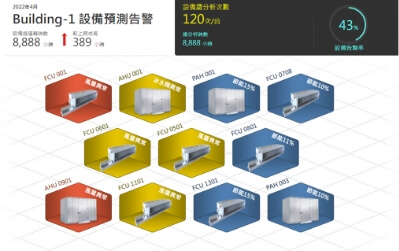We took the lead in introducing the digital twin framework into the construction industry, creating a fast and precise digital twin simulation engine for buildings. Our system encompasses all data throughout a building’s lifecycle. By inputting physical data such as building materials, spatial design, and environmental factors, customers can visualize the entire lifecycle of the building, from conceptual design to end-of-life phases. The integrated AI models enable rapid deployment and pre-training, allowing customers to predict future events and proactively prevent incidents through carbon reduction assessment, analytics, and long-term building energy-efficiency strategies and suggestions.
Embodied carbon refers to the carbon emissions throughout the lifecycle of a building, from the production of building materials, manufacturing, construction to the final demolition and recycling stages. It is worth-noting that embodied carbon emissions account for 28% of a building’s total carbon footprint.
Develops a dedicated digital twin model using real-world physical data for fast calculations and analysis of various outcomes
Simulating building heat transfer and analyzing airflow during the building design phase to meet high performance and comfort indicators
Forecasting equipment failures and maintenance needs and using AI to detect anomalies to provide early warning alerts
Integrating real-time weather conditions into calculation to determine the best equipment operation strategies. Connecting the equipment directly to the central control system for large-scale calculations and control to enable long-term energy efficiency and near-zero carbon management for buildings
Integrating smart building data with environmental monitoring devices to improve management efficiency and save time and costs
Evaluating equipment’s environmental control efficiency and energy performance while predicting potential equipment issues such as aging, failures, and other issues


Creating AI-specific models for scenario-based calculations and optimizing control through remote management of HVAC, outdoor air, and shading equipment
Calculating past, current, and future carbon emissions in various areas of a building by inputting its historical data, including predicting carbon emissions related to materials, activities and energy consumption.

This site uses cookies to personalize your experience, and analyze site traffic. By clicking “Accept” to browse the site you are agreeing to our use of cookies. See our Privacy Policy here.